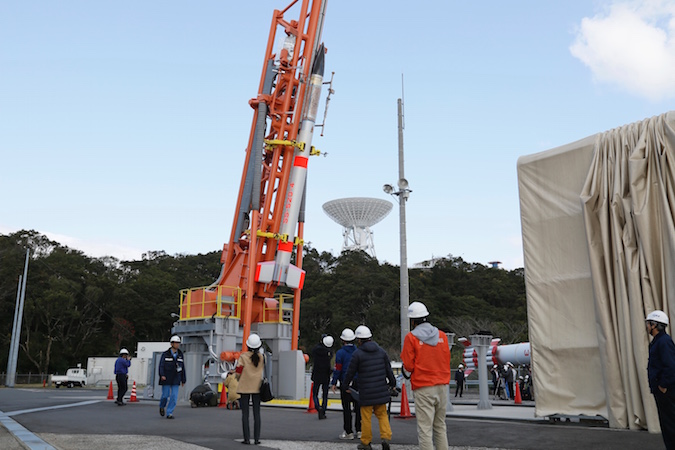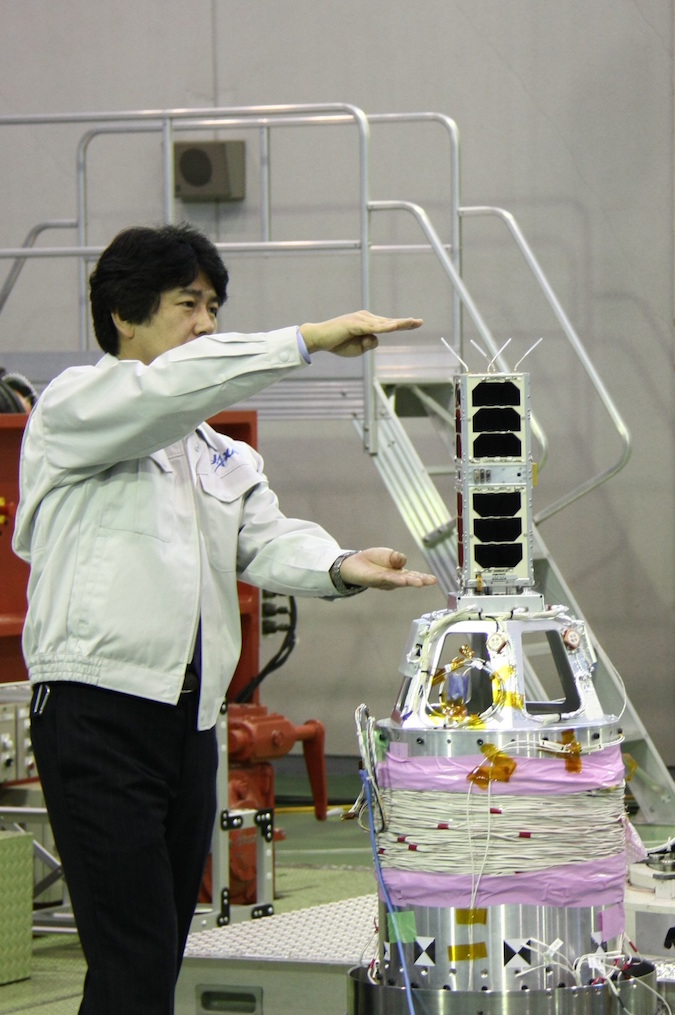Launch of experimental Japanese rocket scrubbed – Spaceflight Now (original) (raw)
The SS-520-4 launcher is in position for liftoff in this photo from the Uchinoura Space Center taken Monday. Credit: JAXA
The launch of an experimental fin-stabilized Japanese rocket with a shoebox-sized CubeSat was scrubbed Tuesday, pushing back a test flight to demonstrate how companies and institutions can inexpensively put small satellites in space.
The modified sounding rocket, designated the SS-520-4, was scheduled to fire into the sky from the Uchinoura Space Center in southern Japan’s Kagoshima prefecture at 2348 GMT (6:48 p.m. EST) Tuesday, or 8:48 a.m. Japan Standard Time Wednesday.
Japanese officials announced a few minutes before the launch that the flight would be postponed due to bad weather at the space base. Authorities did not immediately set a new launch date.
The SS-520-4 will try to become the smallest rocket to ever put an object in orbit. Its sole payload is the six-pound (three-kilogram) TRICOM 1 spacecraft, a CubeSat from the University of Tokyo designed for communications and Earth observation experiments.
Standing 31 feet (9.5 meters) tall and spanning around 20 inches (52 centimeters) in diameter, the SS-520-4 will blast off from a rail launch system and head east over the Pacific Ocean, dropping its lower two stages and payload enclosure into the sea in the first few minutes of the flight.
Primarily funded by a $3.5 million budget provided by the the Japanese government’s Ministry of Economy, Trade and Industry, the SS-520-4 program is a one-off demonstration by Japan’s space agency, which aims to validate low-cost technology and launch operations procedures for a future “nano-launcher” to deploy tiny satellites in orbit on dedicated rides.
The Japan Aerospace Exploration Agency said the research and development project aims to demonstrate a relatively inexpensive launch concept using commercially-available technology.
The launch is purely an experiment, and the student-developed TRICOM 1 CubeSat stowed in the nose of the SS-520-4 booster is as much an educational tool as a space research probe.
The TRICOM 1 satellite. Credit: JAXA
If the SS-520-4 rocket’s flight goes as planned, it will become the smallest and lightest vehicle to ever put an object in orbit.
The small-scale satellite launcher is based on Japan’s SS-520 sounding rocket, a two-stage vehicle developed by IHI Aerospace and JAXA’s Institute of Space and Astronautical Science, which has flown twice on suborbital research missions from Uchinoura and Svalbard, Norway, in 1998 and 2000.
The SS-520 is designed to propel more than 300 pounds (140 kilograms) of science research instrumentation to an altitude of nearly 500 miles (800 kilometers) for a few minutes of exposure to space before falling back to Earth.
Engineers added a third stage on top of the basic SS-520 booster to give it the capability to reach orbital speeds of more than 17,000 mph (27,000 kilometers per hour).
According to JAXA documents, the SS-520-4 will weigh nearly 2.9 tons (2.6 metric tons) at launch, with nearly 2.2 tons (2 metric tons) of that weight made up of pre-packed solid propellants. The SS-520-4’s first stage is loaded with nearly 3,500 pounds (1,587 kilograms) of HTPB solid fuel, while the second and third stages will burn 716 pounds (325 kilograms) and 172 pounds (78 kilograms) of propellant, respectively.
The rocket will target an orbit ranging between 111 miles (180 kilometers) and 932 miles (1,500 kilometers) in altitude, with an inclination of 31 degrees.
A timeline of the launch from JAXA is published below.
- T-00:00: Liftoff
- T+00:31.7: First stage burnout at an altitude of 85,000 feet (26 kilometers)
- T+01:05: Nose cone separation at an altitude of 48 miles (78 kilometers)
- T+01:06: First stage separation at a downrange distance of 18 miles (29 kilometers)
- T+02:37: Second stage ignition time calculation
- T+02:50: Second stage ignition at an altitude of 108 miles (174 kilometers)
- T+03:14.4: Second stage burnout at a velocity of 8,050 mph (3.6 kilometers/hour)
- T+03:45: Second stage separation at a downrange distance of 142 miles (229 kilometers)
- T+03:48: Third stage ignition at an altitude of 115 miles (186 kilometers)
- T+04:13.6: Third stage burnout at a downrange distance of 222 miles (358 kilometers)
- T+07:30: TRICOM 1 separation
Email the author.
Follow Stephen Clark on Twitter: @StephenClark1.
- CubeSats
- IHI Aerospace
- Japan
- JAXA
- SS-520
- SS-520-4
- TRICOM 1
- Uchinoura Space Center
- University of Tokyo

